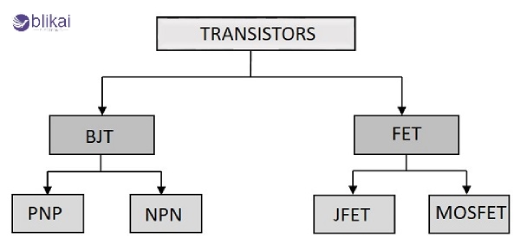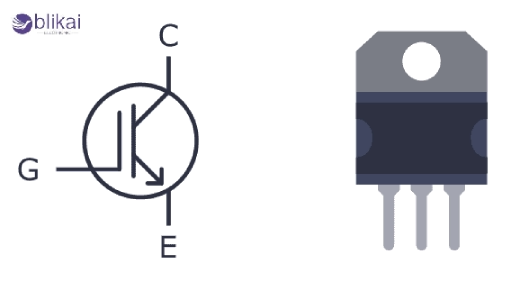5477 Transistor Types: Variants, Features & Applications Guide

Understanding Transistor Basics
Modern electronics operate through transistors as their essential foundational semiconductor devices. The small components function both as device switches and amplifiers to manage electrical current travel through circuits. Monolithic transistors use three terminals, which include the emitter and base, together with the collector in bipolar and source gate with the drain in field-effect designs. Voltage applications at the base or gate of transistors enable users to control the current movements between the other terminals thus performing amplification or switching actions.
Main Categories of Transistors
A. Bipolar Junction Transistors (BJTs)
The fundamental components of present-day electronics exist within Bipolar Junction Transistors (BJTs). The three-terminal bipolar junction transistor equips two PN junctions that exist in either NPN or PNP form. Bipolar Junction Transistors demonstrate excellent current amplification capabilities because they dominate analog circuit applications for signal processing and amplification.
B. Field-effect transistors (FETs)
The basic operation mode of Field-Effect Transistors differs from BJTs because it depends on electric field regulation of current circulation. Because FETs operate by voltage control, they provide both high input resistance along with minimal noise. High-tech digital circuitry uses these vital devices as its main components in integrated circuits.
C. Unijunction Transistors (UJTs)
Devices that comprise Unijunction Transistors feature three terminals which contain one PN junction. The negative resistance features of these devices make them suitable for timing circuit use and oscillator operation. UJTs find essential use in thyristor triggering circuits alongside remaining less popular compared to BJTs and FETs in the marketplace.
D. Insulated Gate Bipolar Transistors (IGBTs)
When combined into insulated gate bipolar transistors these two semiconductor devices deliver high current capacity along with controlled switching through voltage signals. These devices serve primary roles in motor drives and power supplies together with renewable energy systems because of their essential operational capabilities. Power electronics applications require these devices because they can handle huge current flows at elevated voltages.

Exploring Bipolar Junction Transistors
NPN transistors: Structure and operation
An NPN transistor contains three semiconductor areas that integrate the base of p-type material between n-type sections (emitter and collector). The foundation behind their functioning exists in controlling electron passage between the emitter and collector. The base-emitter junction controls the movement of current, which leads to substantial collector-emitter current production.
PNP transistors: Structure and operation
The PNP design of the transistor follows the same arrangement as NPN by surrounding an n-type base with emitter and collector parts of p-type material. Holes function as primary carriers in PNP transistors such that they travel from the emitter through to the collector. The operational mechanism functions as in NPN devices yet with opposite electrical charging schemes.
Key features and advantages of BJTs
When used for amplification, BJTs demonstrate an exceptional capability to increase current flow. These components show excellent resistance to heat fluctuations when used at high radio frequency ranges. BJT transistors have an intrinsic ability to produce minimal noise; thus, they excel in applications requiring audio fidelity and other similar applications.
Common applications in amplification and switching
The amplification process benefits from BJTs which are widely employed in audio systems as well as radio frequency circuits and voltage regulators. The amplification of small signals is where BJTs demonstrate their excellence because their high current gain provides the most benefit during these operations. The switching function of BJTs appears in digital logic circuits and motor controls while they help power management systems.
Diving into Field-Effect Transistors
Junction Field-Effect Transistors (JFETs)
A voltage control system in JFET devices manipulates the dimension of the conducting channel for operations. JFETs exist in two distinct variants: N-channel and P-channel types. JFETs achieve high input resistance and minimal noise level, which makes them suitable for delicate systems.
Metal-Oxide-Semiconductor Field-Effect Transistors (MOSFETs)
The MOSFET represents the prevalent variety of FET devices because it implements a gated mechanism that regulates current movement. The devices exist in two operation modes for N-channel and P-channel technology options. High-frequency and power management applications prefer MOSFETs because these devices operate effectively for fast switching operations.
Comparison of JFETs and MOSFETs
Both devices function as voltage-controlled devices, but the JFET and MOSFET devices exhibit different operational features. The basic design of JFETs maintains a permanently activated state, while MOSFET displays both an activated and deactivated state. Rent properties of MOSFET devices reach higher levels than those of JFETs, although these devices yield superior noise performance in particular conditions.
Applications in low-noise amplifiers and voltage-controlled resistors
The sensitivity of FETs makes them perfect for applications that need low amounts of noise and high impedance levels. JFETs serve as the prime choice for low-noise amplifiers in audio applications along with instrumentation systems, yet MOSFETs perform best in signal processing applications with voltage-controlled resistors for gain control. FET devices serve analog circuits extensively, mainly in scenarios that require high precision and low signal distortion.
Unijunction Transistors: Unique Characteristics
Structure and working principle
UJTs represent one-of-a-kind three-terminal semiconductor devices that form a structural design different from typical transistors. The semiconductor device includes a dopant-disturbed N-type silicon bar and the electrical connections Base 1 (B1) and Base 2 (B2), along with the P-type emitter component. The emitter position closer to Base 2 gives the entire structure an asymmetrical layout.
The operation mechanism of UJTs relies on the variable resistance relationship between their two base terminals. The silicon bar develops a potential gradient as B1 and B2 electrodes receive electrical voltage. When the emitter voltage rises past a critical threshold, it forms an injection point, which then reduces the resistance between the emitter and B1 abruptly.
Advantages over conventional transistors
UJTs deliver better operational advantages than regular transistors do. The one-of-a-kind design of UJT creates negative resistance capabilities that enable oscillator and timing circuits to function properly. The devices present a high impedance to input signals and create precise high-voltage spikes, which work well for trigger operations. UJTs preserve their stability by exhibiting superior performance even as temperatures shift because they display more steady behavior than regular transistors do.
Applications in timing circuits and oscillators
The unique features of UJTs create excellent conditions for oscillator and timing circuit applications. UJTs enable relaxation oscillators to produce uniform and repeatable pulse signals by requiring only minor external components. UJTs function widely in three major electronic systems: these include sawtooth wave generators, voltage-controlled oscillators and pulse-width modulation circuits. UJTs demonstrate excellent timing characteristics for time-delay relays because they offer precise triggering, which delivers accurate timing intervals.
Insulated Gate Bipolar Transistors: Power Control
Combining BJT and MOSFET technologies
IGBTs serve as the successful integration of distinct transistor features when using MOSFET and BJT technologies together. The device integrates beneficial elements from both transistor types into an innovative construction that enables peak functionality for high-power use.
Because they have inherited MOSFET technology, IGBTs permit simple gate voltage control, leading to efficient device switching. Together with BJT's high-current capabilities, they also employ MOSFET functionality. Such combined features deliver a transistor that enables efficient power control through its capability to regulate both high voltage inputs and strong current outputs.
High-power handling capabilities
The compelling benefit that IGBTs provide is their outstanding ability to handle large amounts of power. These devices provide voltage management for kilovolts and functional capability for currents measuring hundreds of amperes. The device achieves its high power-handling capacity by using an organization that optimizes both on-state voltage drop and switching losses.
High-current operation enables IGBTs to produce lower conduction losses in comparison to traditional MOSFETs in various high-power applications. The quick transition from on to off states gives IGBTs superior ability to optimize power control applications.
Applications in motor drives and power supplies
The combination of features that define IGBTs specifically enables their utilization in motor drive and power supply systems. Electrical motor control that uses IGBTs operates as an efficient dual-purposed method to manage both speed and torque in motor drive systems. Running at a fast pace and maintaining top power levels positions IGBTs as the preferred choice for industrial variable frequency drives.
Choosing the Right Transistor
Factors to consider in transistor selection
Every circuit requires certain voltage and current specifications that should inform your transistor selection process. Refraining from this step will lead you to choose the appropriate transistor type along with size. The following step requires you to assess how fast your system needs to switch operations. High-frequency operations require particular transistors which perform better than others designed for low-frequency applications. Power dissipation must receive attention because high currents or voltages introduce important design requirements. The operating temperature range for the transistor needs examination because changing temperatures can degrade its reliability as well as impact its performance.
Matching transistor types to specific applications
The selection of transistors happens according to their compatibility with different applications. Each transistor type finds success in specific usage domains. Audio amplifiers rely on bipolar junction transistors (BJTs) because they provide superior current management abilities. High-impedance circuits, together with voltage-controlled applications, make use of Field-effect transistors (FETs). Understanding device requirements enables power electronics designers to choose insulated gate bipolar transistors (IGBTs) since they deliver efficient high voltage and current management. There exists a specific application for unijunction transistors within timing and oscillator circuits.
Related Articles
Understanding Bipolar Junction Transistor (BJT): A Beginner's Guide
What is a 2N3904 Transistor & How Does it Work?
BJT vs MOSFET: Key Differences, Applications, and Choosing the Right Transistor
Transistor Symbol Explained: Understanding the Basics and Types
Multimeter Not Reading Current [How to Fix]
Multimeter Not Reading DC Voltage: How to Fix it?
What are Lighting Ballasts?
Temperature Coefficient of Resistance
The Automotive PCB Market Seizes Fresh Opportunities
Cross Sectional Area of Wire: Everything You Need to Know
Exploring Varied Types of Inverters
L7805ABV Voltage Regulator: Overview, Features, and Applications
TPS54231DR Regulator: Features, Applications and Datasheet
10k Resistor Color Code: Everything You Need to Know










